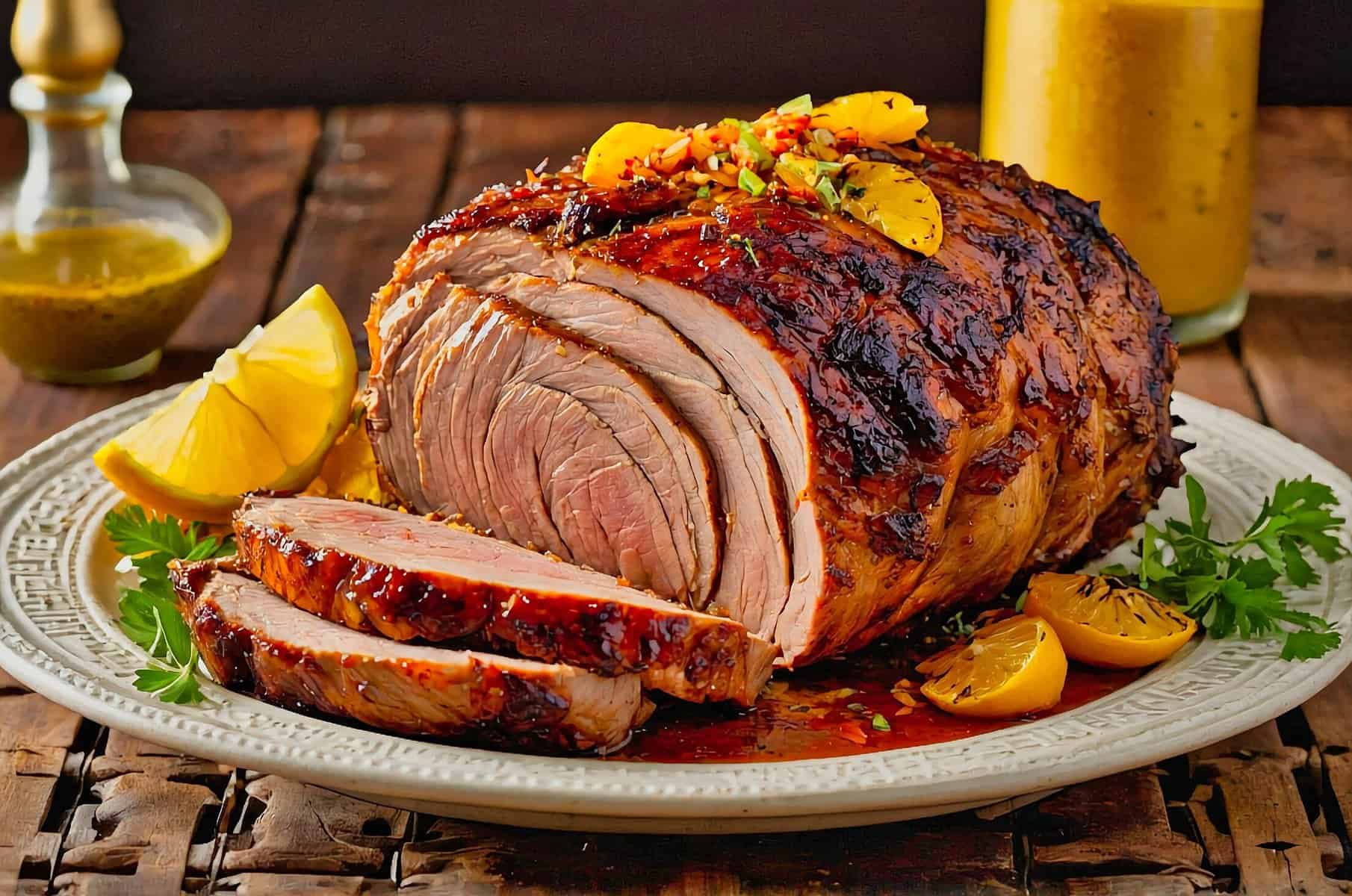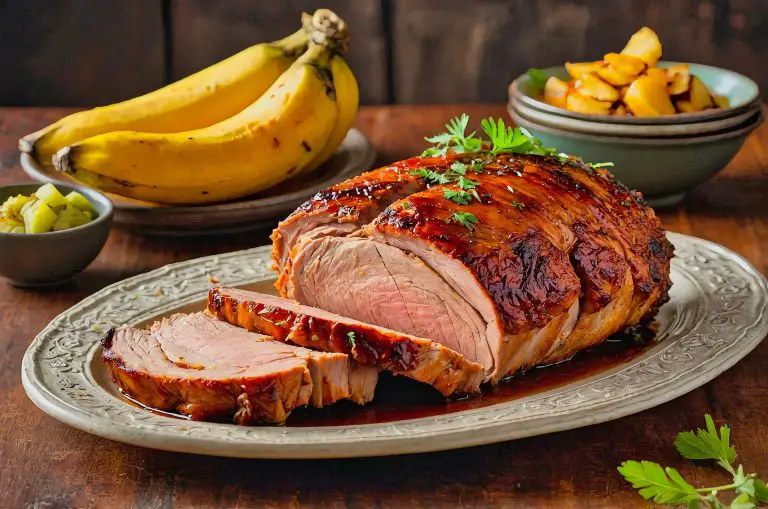Venezuela Pork Roast Recipe
My favorite recipe for Venezuela Pork Roast recipe was from Barquisimeto, Venezuela. My trip to this city included a cooking class to sample the local cuisine for my food blog. Barquisimeto, sometimes called the “City of the Twilight,” is a culturally significant and a thriving music city.
Barquisimeto is in Lara state Venezuela, a mild climate and picturesque region. Attractions include the Obelisco de Barquisimeto (a colossal structure) and the Barquisimeto Cathedral (a modern masterpiece). Visitors can also visit the Flor de Venezuela, a giant flower pavilion featuring the region’s flora. The Museo de Barquisimeto also preserves the area’s history and culture.
The Venezuela Pork Roast recipe came from a local chef in a hands on cooking class. It involves marinating pork in spices, citrus juices and Venezuelan seasonings and slow roasting to perfection. The instructor said you want to balance the marinade for that signature taste. In the class I saw how the cooking process brought out the flavours and techniques for making a roast in a new way.
The first thing I tasted as I prepared the Venezuela Pork Roast recipe was the savoury, spicy and mildly sweet flavour profile. The pork was tender and the exterior was caramelised. It was juicy but firm and a nice main dish. This recipe is a favorite of locals and is served during family gatherings and celebrations, demonstrating its place in Venezuelan culture.
Barquisimeto is a city beyond cuisine. From its music festivals to its history, there’s something for everyone. Learning the Venezuela Pork Roast recipe gave me insight into the city gastronomic traditions and a new perspective on my food blog.
Ingredients
Pulled Pork
2 Tbsp Vegetable Oil
2 lbs pork, boneless shoulder cut into 2 inch cubes
1 Onion, finely chopped
2 Cloves Garlic, finely chopped
1 cup Chicken Broth (affiliate)
1 cup Orange Juice
Arepas
2 cups Dehydrated Cooked Cornmeal
3 cups Boiling Water
1/2 Tsp Salt
1/4 cup Vegetable Oil
Toppings
1 cup Cotija Cheese, crumbled
1/2 cup Cilantro, chopped
2 Limes, cut into wedges
2 cans Black Beans
1/2 teaspoon Salt
1/4 teaspoon Cinnamon
1/4 teaspoon Cumin
1/2 teaspoon Paprika
Directions
- To make pulled pork, heat oil in large stockpot over medium high heat, then brown pork shoulder pieces on all sides, about 10 minutes. Add in onion and garlic and saute 2 more minutes. Pour chicken broth and orange juice over top, put lid on pot, and let simmer on low until tender, about 2 1/2 hours.
- When pork has about an hour left, start to make your cornmeal arepas. Preheat oven to 400 degrees. Add boiling water to cornmeal and salt in mixing bowl, and stir until completely combined.
- Heat 1/4 cup vegetable oil in large skillet and form cornmeal dough into patties about 3/4 inch thick and 4 inches in diameter. Place cornmeal patties in skillet and cook for 5 minutes on each side. Place on baking sheet and bake arepas in oven for 15-20 minutes.
- While arepas are in the oven, combine drained black beans with salt, cinnamon, cumin, and paprika in small saucepan and bring to a boil.
- To assemble arepas, slice patties in half and stuff with shredded pulled pork, black beans, cilantro, and queso fresco.
- Garnish with lime.
Why I Love Venezuela Food
Venezuelan cuisine combines bold flavours, textures and ingredients. Each dish reveals its cultural heritage and influences over the centuries. I had the opportunity of being exposed to various cuisines as a child, however Venezuelan foods stands apart because of being able to bring excitement and comfort to the table.
One of the reasons I like Venezuelan food is they use corn as a staple. Arepas, for example, are a national dish. These cornmeal cakes are cooked to perfection and can be stuffed with fillings like cheese, shredded beef or avocado chicken salad (reina pepiada). They’re a reminder of just how simple ingredients can make something spectacular. The pleasure of biting into a warm arepa is unparalleled – at breakfast, lunch or dinner.
A highlight of Venezuelan cuisine is regional diversity. From the coasts to the Andean mountains, each region contributes specific ingredients and cooking methods. On the coast, seafood dishes like pescado frito and caz’n empanadas highlight the catch. Inland, the focus shifts to hearty meals like pabell’ n criollo, Venezuela’s national dish. Shredded beef, rice, black beans and fried plantains combine for a satisfying combination of textures and flavours that recall Venezuelan culinary traditions.
A staple in Venezuelan food are plantains. Whether sliced and fried as tajadas (thinly sliced and golden) or flattened and fried as patacones (a crispy base), plantains add sweetness or savoury to meals. I love that plantains can make a dish feel complete by adding a layer of depth that makes even the simplest meal feel complete!
No discussion of Venezuelan food would be complete without mentioning hallacas, a traditional holiday dish. Hallacas are handmade from banana leaves and filled with meat, olives, raisins and capers. Preparing them is often a family activity during the festive period. The combination of flavours and the care given to each hallaca makes it a meal to remember.
I love its cuisine is Venezuelan street food. From empanadas to tequeos, there’s creativity and decadence in every bite. Tequeos in particular are a favourite of mine. Cheese-filled pastries fried to golden perfection are a favorite snack at parties and gatherings. Serving them with a dipping sauce makes a simple snack a memorable one.
And last but not least, the beverages that go with Venezuelan meals so well. Chicha is a refreshing rice drink. Papel’ n con lim’n is made with unrefined cane sugar and lime. These beverages complement dining and reflect the country’s use of natural ingredients.
What I really like about Venezuelan food is the community. The cuisine is about sharing: whether it is a plate of arepas for a family dinner or a batch of hallacas for the holidays. Venezuelan food is more than food; it’s culture. It is a celebration of love, tradition & togetherness. Every bite tells a story and every meal is a voyage through the country’s culture. This combination of delicious flavours and heartfelt experiences is why I love Venezuelan cuisine.
Where to Find Local Restaurants and Diner Favorites in Venezuela
Caracas, the capital of Venezuela, offers numerous culinary delights which includes traditional Venezuelan dishes. Regardless of whether you might be a visitor attempting to try traditional Venezuelan food or a local trying to explore new dining places, knowing where to eat can mean the difference. Caracas boasts a mix of street food, classic diners and contemporary restaurants for anyone looking for true Venezuelan flavours. Understanding where you can look and the way to navigate the dining scene will help you obtain the very best dining the city is offering.
For local food to try in Caracas, head to the neighbourhoods where dining culture abounds. Areas like Chacao and Sabana Grande are full of food establishments. These neighbourhoods offer everything from small, family-owned diners serving traditional fare to hipster eateries presenting modern interpretations of Venezuelan classics. Walking through these districts is a good way to find hidden gems that locals frequent. Watch the spots that have a steady stream of patrons: Those are often the best clues to quality and authenticity.
Street food is among Caracas’ culinary traditions and also consists of several of the city’s most famous dishes. For street food vendors, go to plazas and busy avenues like Plaza Venezuela or Avenida Francisco de Miranda. Vendors of arepas, empanadas and cachapas are just some of the local fare. Asking locals which stalls are best may help you identify the best. Ask vendors or regular customers for recommendations – they often know where to get the best bites in the area.
One other way to find the best local restaurants is to find traditional Venezuelan dishes which are regional specialties. Restaurants offering pabellon criollo, asado negro and hallacas tend to use the traditional techniques and flavours. Look for spots that feature fresh, local ingredients; these tend to be quality – focused. Family-run diners and small restaurants (“comedores”) are popular in Caracas for home-style cooking.
Find great dining in Caracas using social media and online reviews. Platforms such as Instagram and Google Maps host photos, reviews and ratings from both locals and visitors alike. Look up hashtags like Venezuelan food or Caracas dining to find recommendations on everything from hidden eateries to must-try street food. Also try joining local food forums or Facebook groups to meet locals who want to share their favourite spots.
Caracas also boasts a burgeoning food tour industry to help you find local favorites. Guided tours by locals can introduce you to some of the city’s authentic dishes and give insight into the food culture. These tours often include stops at both famous and lesser-known places, so you can sample more of Caracas cuisine.
Lastly, the most effective way to discover the very best dining options in Caracas is asking locals. Venezuelans are known for their hospitality and sharing of food culture. Nearly everybody is going to tell you about their favourite restaurants or street food sellers in case you ask a taxi driver, a passerby or a shopkeeper. Trusting their suggestions often means memorable meals and real experiences.
You can find the best local restaurants and diner favourites in Caracas by wandering neighbourhoods, sampling street food and asking locals and online platforms for recommendations. The city’s vibrant dining scene provides ample opportunities to sample the varied Venezuelan cuisine.
FAQs For the Venezuela Pork Roast Recipe
Q: What is the Venezuela Pork Roast recipe and what makes it unique?
A: The Venezuela Pork Roast recipe features a whole pork roast marinated with a blend of garlic, cumin, oregano, and citrus juice, then slow-cooked until tender. The dish is known for its flavorful, crispy skin and its savory, tangy taste, often served with a side of rice or plantains.
Q: Can I use a different cut of meat for the Venezuela Pork Roast recipe?
A: While a pork shoulder or pork loin is traditionally used for the Venezuela Pork Roast recipe, you can also experiment with other cuts like pork belly or tenderloin. Just adjust the cooking time to ensure the meat remains tender and juicy.
Q: How long should I cook the Venezuela Pork Roast recipe for optimal tenderness?
A: The Venezuela Pork Roast recipe typically requires slow roasting for about 3-4 hours at a low temperature (around 300°F/150°C). This ensures the meat is tender and easily pulled apart. Always check the internal temperature to make sure it reaches at least 145°F (63°C) for safety.
Q: Can I make the Venezuela Pork Roast recipe ahead of time?
A: Yes, you can prepare the Venezuela Pork Roast recipe ahead of time. You can marinate the pork overnight and cook it the next day. Leftovers can be stored in the fridge and reheated for up to 3 days, or frozen for longer storage.
Q: What sides pair well with the Venezuela Pork Roast recipe?
A: The Venezuela Pork Roast recipe pairs excellently with traditional sides like rice, beans, fried plantains, or a fresh salad. You can also serve it with a spicy salsa or a tangy dipping sauce for added flavor.

Venezuela Pork Roast Recipe
Ingredients
- 2 Tbsp Vegetable Oil
- 2 lbs pork boneless shoulder cut into 2 inch cubes
- 1 Onion finely chopped
- 2 Cloves Garlic finely chopped
- 1 cup Chicken Broth affiliate
- 1 cup Orange Juice
- 2 cups Dehydrated Cooked Cornmeal
- 3 cups Boiling Water
- 1/2 Tsp Salt
- 1/4 cup Vegetable Oil
- 1 cup Cotija Cheese crumbled
- 1/2 cup Cilantro chopped
- 2 Limes cut into wedges
- 2 cans Black Beans
- 1/2 teaspoon Salt
- 1/4 teaspoon Cinnamon
- 1/4 teaspoon Cumin
- 1/2 teaspoon Paprika
Instructions
- To make the pork, heat oil in large stockpot over medium high heat, then brown pork shoulder pieces on all sides, about 10 minutes. Add in onion and garlic and saute 2 more minutes. Pour chicken broth and orange juice over top, put lid on pot, and let simmer on low until tender, about 2 1/2 hours.
- When pork has about an hour left, start to make your cornmeal arepas. Preheat oven to 400 degrees. Add boiling water to cornmeal and salt in mixing bowl, and stir until completely combined.
- Heat 1/4 cup vegetable oil in large skillet and form cornmeal dough into patties about 3/4 inch thick and 4 inches in diameter. Place cornmeal patties in skillet and cook for 5 minutes on each side. Place on baking sheet and bake arepas in oven for 15-20 minutes.
- While arepas are in the oven, combine drained black beans with salt, cinnamon, cumin, and paprika in small saucepan and bring to a boil.
- To assemble arepas, slice patties in half and stuff with shredded pulled pork, black beans, cilantro, and queso fresco.
- Garnish with lime.




4 comments
Great pork roast recipe.
I cant believe they used pineapple in the Venezuela Pork Roast recipe! Who wouldve thought that combo would work? I might just have to give it a try and see for myself.
I cant believe they didnt mention adding a splash of rum to the Venezuela Pork Roast Recipe! Its a game-changer, trust me. Whos with me on this culinary adventure?
I cant believe they didnt mention the secret ingredient in the Venezuela Pork Roast recipe! Everyone knows its the key to making it perfect. Who else swears by adding a splash of rum? 🥃